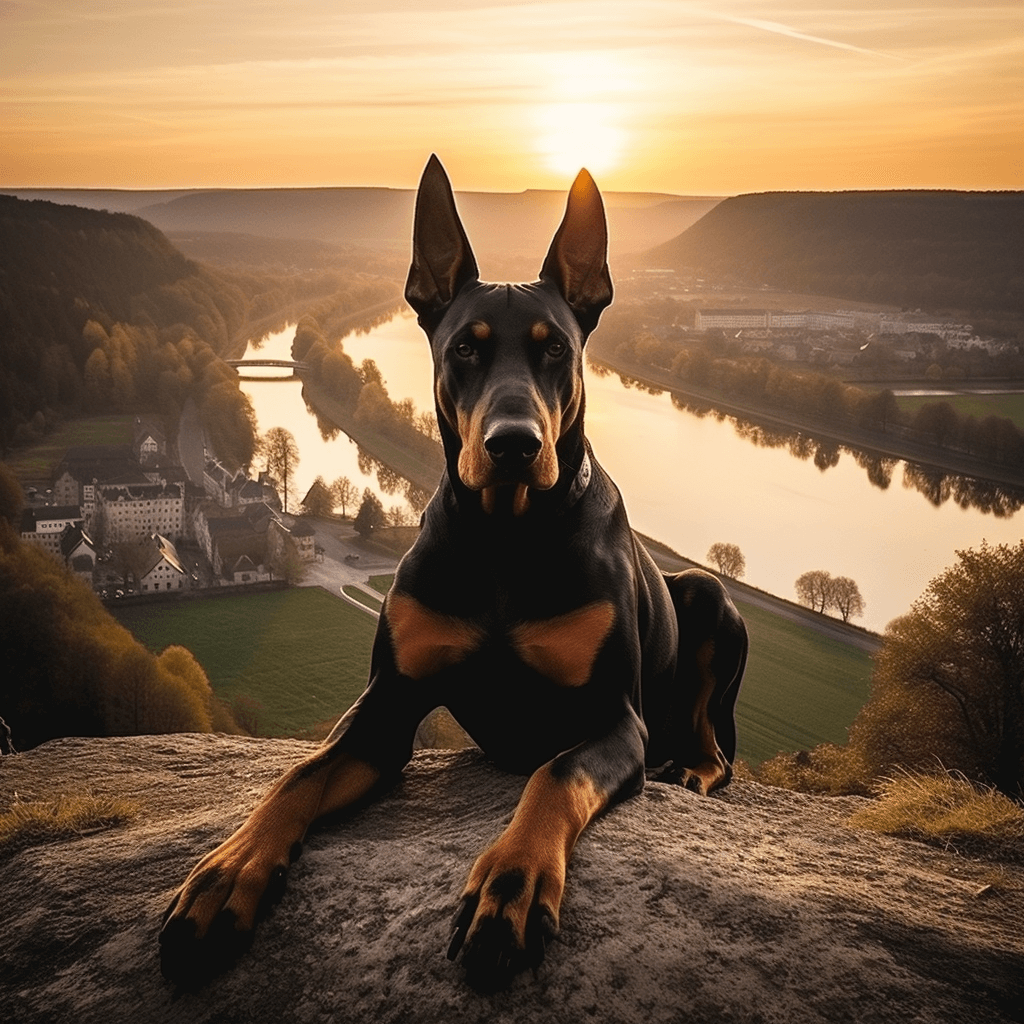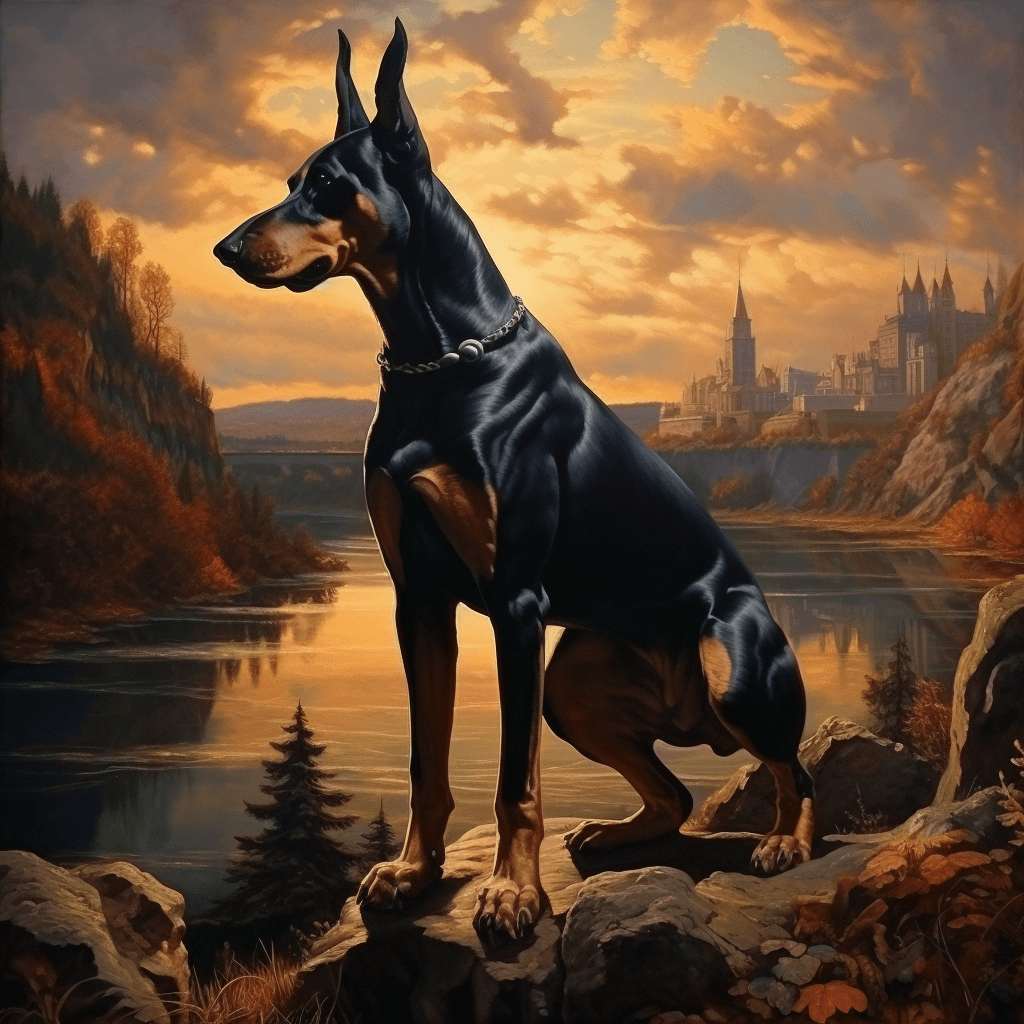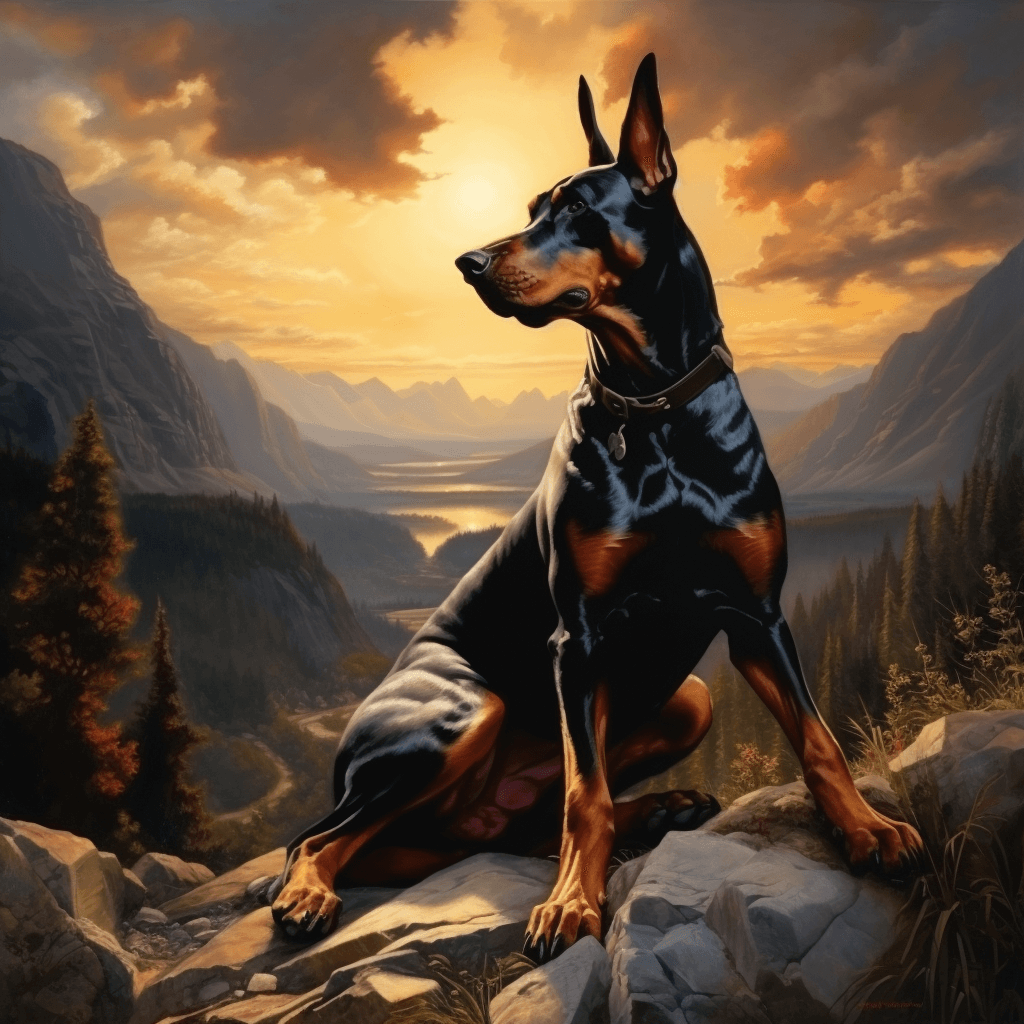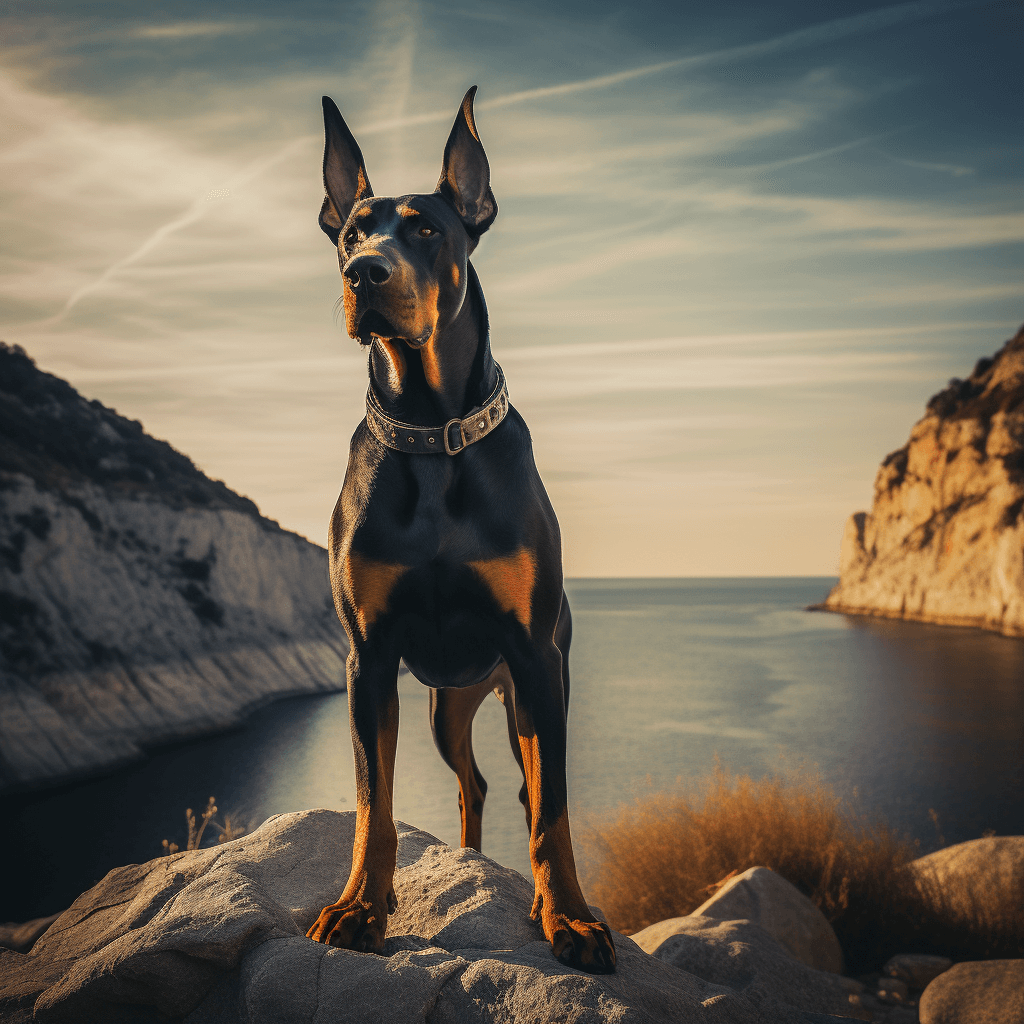The Doberman Pinscher, often referred to as the Doberman is a distinct and popular breed known for its intelligence, loyalty, and protective instincts. Here's a brief history of the Doberman:
Origin: The Doberman Pinscher was developed in the late 19th century in Germany by a tax collector named Louis Dobermann. He wanted a loyal and protective companion to accompany him during his rounds through dangerous areas. To achieve this, he carefully bred several dog breeds, including the Rottweiler, German Pinscher, Greyhound, Weimaraner, and Black and Tan Terrier.
Origin: The Doberman Pinscher was developed in the late 19th century in Germany by a tax collector named Louis Dobermann. He wanted a loyal and protective companion to accompany him during his rounds through dangerous areas. To achieve this, he carefully bred several dog breeds, including the Rottweiler, German Pinscher, Greyhound, Weimaraner, and Black and Tan Terrier.

Breed Standard: The breed was officially recognized in 1900 and named after its creator, Louis Dobermann. Over time, breed standards were established to maintain specific characteristics, including sleek appearance, alertness, and protective instincts.
Characteristics: Dobermans are medium- to large-sized dogs known for their muscular build, short coats, and distinct black and tan markings. They have a sleek, elegant appearance and stand out for their cropped ears and docked tails, although these practices are becoming less common due to changing attitudes and laws.
Temperament: Dobermans are intelligent, loyal, and protective dogs. They are often described as "velcro dogs" because of their strong bond with their owners. They are known for their alertness and make excellent guard dogs.
Working Dogs: Dobermans have been employed in various roles, including police work, search and rescue, and as service dogs. Their intelligence and trainability make them highly suited for these tasks.
Health Considerations: Like all breeds, Dobermans can be prone to specific health issues, including hip dysplasia, heart problems (such as dilated cardiomyopathy), and von Willebrand's disease (a blood disorder). Responsible breeding and regular veterinary care are essential to maintain their health.
Lifespan: The average lifespan of a Doberman is around 10 to 13 years, although some individuals may live longer with proper care.
Popularity: Dobermans are consistently ranked among the top 20 most popular dog breeds in the United States.
Family Dogs: When properly trained and socialized from a young age, Dobermans can be excellent family pets. They are protective of their families and are typically good with children.
Legacy: The Doberman Pinscher has a lasting legacy as a loyal and protective companion. They are highly regarded for their work in various roles, particularly in law enforcement and as service dogs. Despite their imposing appearance, they are known for their loving nature and strong bond with their owners.
Overall, the Doberman Pinscher is a breed with a rich history, valued for its intelligence, loyalty, and protective instincts.
Characteristics: Dobermans are medium- to large-sized dogs known for their muscular build, short coats, and distinct black and tan markings. They have a sleek, elegant appearance and stand out for their cropped ears and docked tails, although these practices are becoming less common due to changing attitudes and laws.
Temperament: Dobermans are intelligent, loyal, and protective dogs. They are often described as "velcro dogs" because of their strong bond with their owners. They are known for their alertness and make excellent guard dogs.
Working Dogs: Dobermans have been employed in various roles, including police work, search and rescue, and as service dogs. Their intelligence and trainability make them highly suited for these tasks.
Health Considerations: Like all breeds, Dobermans can be prone to specific health issues, including hip dysplasia, heart problems (such as dilated cardiomyopathy), and von Willebrand's disease (a blood disorder). Responsible breeding and regular veterinary care are essential to maintain their health.
Lifespan: The average lifespan of a Doberman is around 10 to 13 years, although some individuals may live longer with proper care.
Popularity: Dobermans are consistently ranked among the top 20 most popular dog breeds in the United States.
Family Dogs: When properly trained and socialized from a young age, Dobermans can be excellent family pets. They are protective of their families and are typically good with children.
Legacy: The Doberman Pinscher has a lasting legacy as a loyal and protective companion. They are highly regarded for their work in various roles, particularly in law enforcement and as service dogs. Despite their imposing appearance, they are known for their loving nature and strong bond with their owners.
Overall, the Doberman Pinscher is a breed with a rich history, valued for its intelligence, loyalty, and protective instincts.
FCI STANDART
Origin: Germany.
Applications: Companion, guard, and working dog.
FCI Classification: Group 2. Pinscher and Schnauzer, Molossoid and Swiss Mountain and Cattle Dogs.
Origin: Germany.
Applications: Companion, guard, and working dog.
FCI Classification: Group 2. Pinscher and Schnauzer, Molossoid and Swiss Mountain and Cattle Dogs.
Section 1. Pinscher and Schnauzer, with working trial.
BRIEF HISTORICAL OVERVIEW: The Doberman is the only German breed named after its first breeder, Friedrich Louis Dobermann (02.01.1834 - 09.06.1894). He is believed to have been a tax collector, a slaughterhouse worker, and a part-time dog catcher, with the legal right to catch all stray dogs. From this group, he selected animals of a particular type. The so-called "butcher's dogs," considered relatively purebred at the time, played the most crucial role in developing the Doberman breed. These dogs were an early type of Rottweiler, mixed with the Thuringian Shepherd, black with rust-red markings. Mr. Dobermann bred these mixed breeds in the 1870s. Thus, he obtained "his" breed: not just watchful but service and guard dogs with highly developed protective qualities. They were often used as guards and police dogs, earning the nickname "gendarme's dog." They were also used for hunting limited large predators. In these circumstances, it is self-evident that the Doberman was officially recognized as a police dog at the beginning of the twentieth century.
The Doberman is a medium-sized, strong, and muscular dog. Despite its massiveness, it should be elegant and noble in body contours. It is an excellent companion, guard, and working dog, as well as a family dog.
BRIEF HISTORICAL OVERVIEW: The Doberman is the only German breed named after its first breeder, Friedrich Louis Dobermann (02.01.1834 - 09.06.1894). He is believed to have been a tax collector, a slaughterhouse worker, and a part-time dog catcher, with the legal right to catch all stray dogs. From this group, he selected animals of a particular type. The so-called "butcher's dogs," considered relatively purebred at the time, played the most crucial role in developing the Doberman breed. These dogs were an early type of Rottweiler, mixed with the Thuringian Shepherd, black with rust-red markings. Mr. Dobermann bred these mixed breeds in the 1870s. Thus, he obtained "his" breed: not just watchful but service and guard dogs with highly developed protective qualities. They were often used as guards and police dogs, earning the nickname "gendarme's dog." They were also used for hunting limited large predators. In these circumstances, it is self-evident that the Doberman was officially recognized as a police dog at the beginning of the twentieth century.
The Doberman is a medium-sized, strong, and muscular dog. Despite its massiveness, it should be elegant and noble in body contours. It is an excellent companion, guard, and working dog, as well as a family dog.

GENERAL APPEARANCE: The Doberman is of medium size, strong, and muscular build. Thanks to its elegant body lines, proud posture, beauty, and resolute expression, it meets the ideal dog portrait.
IMPORTANT PROPORTIONS: The Doberman's body appears almost square, especially in males. The diagonal length of the body, measured from the shoulder-blade articulation to the buttock protuberance, should not exceed the height at the withers by more than 5% in males and 10% in females.
BEHAVIOR AND TEMPERAMENT: The character of the Doberman is friendly and calm, very devoted to the family, and fond of children. Moderate temperament and moderate vigilance are desirable. A reasonable excitability threshold is necessary for good contact with the owner. Easy to train, the Doberman works with pleasure and should possess proper working abilities, courage, and firmness. Particularly significant are self-confidence, fearlessness, adaptability, and attentiveness to the social environment.
HEAD
CRANIAL REGION: Strong, of medium length. When viewed from above, the head should have a blunt wedge shape. When viewed from the front, the top line should be almost level and not slope towards the ears. The line of the muzzle extends almost straight to the upper line of the skull, which, softly rounding, passes into the line of the neck. The eyebrows are well-developed but not protruding. However, the frontal furrow is visible. The occipital protuberance should not be pronounced. When viewed from the front and above, the head's lateral sides should not be convex. Slight convexity between the rear part of the upper jaw and the cheekbone should be in harmony with the overall length of the head. The head's muscles should be well developed.
Transition from the forehead to the muzzle: Should be weak but distinct.
FACIAL PART
Nose: The nostrils are well developed, broader than in width, with large openings, generally not protruding—black in black dogs and brown dogs, of corresponding, lighter tones.
Muzzle: Should be vigorously developed. In length, it equals the cranial part. It should have depth. The jaws should open wide, reaching the molars. The width of the muzzle should also be in the area of the upper and lower incisors.
Lips: Should be dry and adhere to the jaw to ensure a tight mouth closure. Gum pigmentation should be dark in brown dogs of a corresponding, lighter tone.
Jaws, dental formula, teeth: Strong upper and lower jaws, scissor bite, 42 teeth correctly positioned and of average size.
Eyes: Medium-sized, oval, and dark in color. Slightly lighter shades are allowed in brown dogs. Adhering eyelids, covered with hair. Rings around the eyes are highly undesirable.
Ears: Set high, carried erect. They are proportionally cropped to the head. In countries where cropping is not allowed, uncropped ears are also recognized (primarily medium-sized, with the front edge against the cheek).
NECK: Should be of reasonable length, proportionate to the body and head. Dry and muscular. Its outlines gradually descend in a smooth curve. The vertical position demonstrates significant nobility.
IMPORTANT PROPORTIONS: The Doberman's body appears almost square, especially in males. The diagonal length of the body, measured from the shoulder-blade articulation to the buttock protuberance, should not exceed the height at the withers by more than 5% in males and 10% in females.
BEHAVIOR AND TEMPERAMENT: The character of the Doberman is friendly and calm, very devoted to the family, and fond of children. Moderate temperament and moderate vigilance are desirable. A reasonable excitability threshold is necessary for good contact with the owner. Easy to train, the Doberman works with pleasure and should possess proper working abilities, courage, and firmness. Particularly significant are self-confidence, fearlessness, adaptability, and attentiveness to the social environment.
HEAD
CRANIAL REGION: Strong, of medium length. When viewed from above, the head should have a blunt wedge shape. When viewed from the front, the top line should be almost level and not slope towards the ears. The line of the muzzle extends almost straight to the upper line of the skull, which, softly rounding, passes into the line of the neck. The eyebrows are well-developed but not protruding. However, the frontal furrow is visible. The occipital protuberance should not be pronounced. When viewed from the front and above, the head's lateral sides should not be convex. Slight convexity between the rear part of the upper jaw and the cheekbone should be in harmony with the overall length of the head. The head's muscles should be well developed.
Transition from the forehead to the muzzle: Should be weak but distinct.
FACIAL PART
Nose: The nostrils are well developed, broader than in width, with large openings, generally not protruding—black in black dogs and brown dogs, of corresponding, lighter tones.
Muzzle: Should be vigorously developed. In length, it equals the cranial part. It should have depth. The jaws should open wide, reaching the molars. The width of the muzzle should also be in the area of the upper and lower incisors.
Lips: Should be dry and adhere to the jaw to ensure a tight mouth closure. Gum pigmentation should be dark in brown dogs of a corresponding, lighter tone.
Jaws, dental formula, teeth: Strong upper and lower jaws, scissor bite, 42 teeth correctly positioned and of average size.
Eyes: Medium-sized, oval, and dark in color. Slightly lighter shades are allowed in brown dogs. Adhering eyelids, covered with hair. Rings around the eyes are highly undesirable.
Ears: Set high, carried erect. They are proportionally cropped to the head. In countries where cropping is not allowed, uncropped ears are also recognized (primarily medium-sized, with the front edge against the cheek).
NECK: Should be of reasonable length, proportionate to the body and head. Dry and muscular. Its outlines gradually descend in a smooth curve. The vertical position demonstrates significant nobility.

BODY
WITHERS: Should be strongly pronounced in height and length, especially in males, determining the slope of the top line from the withers to the croup.
Back (from the withers to the loin): Short, compact, comprehensive, and well-muscled.
Loin: Wide and well-muscled. In bitches, it can be slightly longer because there needs to be room for puppies.
Croup: Wide and well-muscled, slightly sloping, barely noticeable from the sacrum to the base of the tail. It should appear well-rounded, not horizontal or sloping.
Chest: The length and width of the chest should be in the correct proportion to the size of the body. The depth of slightly arched ribs should be approximately 50% of the dog's height at the withers. The chest is vast in the well-developed front part.
Lower Line: Noticeably drawn up from the lowest point of the chest to the belly.
TAIL: Set high, cropped short so that about two tail vertebrae remain. In countries where cropping is legally banned, the tail can stay natural.
FORELIMBS
General Appearance: When viewed from all sides, the front legs are almost straight, vertical to the ground, and strongly developed. Shoulders: Sloping, fitting well against the chest, on both sides of the shoulder blade crest, well-muscled, and protruding above the chest part of the back. The angle of inclination to the horizontal is approximately 50 degrees. Humerus: It is of medium length, well-muscled, and forms an angle with the shoulder blades of roughly 105-110 degrees. Elbows: Directed straight backward, not turned out. Forearm: Strong and straight. Well-muscled. Harmonious in length. Carpus (Wrist): Strong. Pasterns: Bone strong. Straight when viewed from the front. When viewed from the side, slightly sloping, a maximum of 10 degrees. Front Feet: Short and cat-like. Compact. Toes arched. Nails are short and dark.
HINDQUARTERS
General Appearance: The croup and thighs appear broad and rounded when viewed from behind due to well-developed hip muscles. Muscles that transition from the hip to the thigh and shin end in good width and the thigh area, at the knee joints and shins. Strong hind legs are straight and stand parallel.
Thighs: Medium length and width, well-muscled, good hip-thigh angle. The angle with the horizontal is approximately 80-85 degrees.
Knees: The knee joint is strong and formed by the thigh, shin, and knee cup. The knee angle is approximately 130 degrees.
Shins: Of medium length, harmonious with the overall size of the hind limbs.
Hock Joints: Moderately solid and parallel. The shin bones connect with the tarsi in the hock joint at an angle of about 140 degrees.
Tarsi (Hocks): Short and stand vertically to the ground.
Hind Feet: Similar to the front feet, the toes of the rear feet are short, arched, and cat-like. Nails are short and dark.
MOVEMENT: This is especially significant for both service use and appearance. Movements are springy, elegant, fast, free, and expansive. A more extensive reach of the front legs is possible. The hind legs are well-extended and pushed with necessary elasticity. One front leg and one hind leg move forward simultaneously. There should be a stable back, ligaments, and joints.
SKIN: Fits tightly all over and is well-pigmented.
COAT
HAIR: Short, complex, and dense. Fits tightly and smoothly distributed over the entire surface. An undercoat is not allowed.
COLOR: Black or brown, with clearly defined and distinct rust-red markings on the muzzle, cheeks, eyebrows, throat, and paws, under the tail, on the inner sides of the hind legs, forearms, and under the tail. Two spots on the chest.
HEIGHT AND WEIGHT
FAULTS: Any deviation from the points mentioned above should be considered a fault, the assessment of which should be in exact proportion to the degree of the deviation.
General Appearance: Deviations in sexual type; excessive bulkiness; overly light or heavy; excessively tall; fine-boned.
Head: Too heavy; too narrow; too short; too long; transition from the forehead to the muzzle too pronounced or too slight; Roman nose; poor top line of the cranial part; weak lower jaw; round or narrow eyes; light eyes; overly developed cheeks; drooping lips; eyes too convex or too profoundly set; ears set too high or too low; wrinkle at the corner of the mouth.
Neck: Somewhat short; too short; loose skin on the throat; dewlap; excessively (disproportionately) long neck; thin neck.
Body:
Limbs:
Coat:
Character: Insufficient self-confidence; overly excitable temperament; heightened alertness; too high or too low threshold of excitability.
Height: For deviations in height up to two centimeters from the standard, the assessment should be reduced.
Movement: Wobbly; restricted or impeded; hackneyed.
WITHERS: Should be strongly pronounced in height and length, especially in males, determining the slope of the top line from the withers to the croup.
Back (from the withers to the loin): Short, compact, comprehensive, and well-muscled.
Loin: Wide and well-muscled. In bitches, it can be slightly longer because there needs to be room for puppies.
Croup: Wide and well-muscled, slightly sloping, barely noticeable from the sacrum to the base of the tail. It should appear well-rounded, not horizontal or sloping.
Chest: The length and width of the chest should be in the correct proportion to the size of the body. The depth of slightly arched ribs should be approximately 50% of the dog's height at the withers. The chest is vast in the well-developed front part.
Lower Line: Noticeably drawn up from the lowest point of the chest to the belly.
TAIL: Set high, cropped short so that about two tail vertebrae remain. In countries where cropping is legally banned, the tail can stay natural.
FORELIMBS
General Appearance: When viewed from all sides, the front legs are almost straight, vertical to the ground, and strongly developed. Shoulders: Sloping, fitting well against the chest, on both sides of the shoulder blade crest, well-muscled, and protruding above the chest part of the back. The angle of inclination to the horizontal is approximately 50 degrees. Humerus: It is of medium length, well-muscled, and forms an angle with the shoulder blades of roughly 105-110 degrees. Elbows: Directed straight backward, not turned out. Forearm: Strong and straight. Well-muscled. Harmonious in length. Carpus (Wrist): Strong. Pasterns: Bone strong. Straight when viewed from the front. When viewed from the side, slightly sloping, a maximum of 10 degrees. Front Feet: Short and cat-like. Compact. Toes arched. Nails are short and dark.
HINDQUARTERS
General Appearance: The croup and thighs appear broad and rounded when viewed from behind due to well-developed hip muscles. Muscles that transition from the hip to the thigh and shin end in good width and the thigh area, at the knee joints and shins. Strong hind legs are straight and stand parallel.
Thighs: Medium length and width, well-muscled, good hip-thigh angle. The angle with the horizontal is approximately 80-85 degrees.
Knees: The knee joint is strong and formed by the thigh, shin, and knee cup. The knee angle is approximately 130 degrees.
Shins: Of medium length, harmonious with the overall size of the hind limbs.
Hock Joints: Moderately solid and parallel. The shin bones connect with the tarsi in the hock joint at an angle of about 140 degrees.
Tarsi (Hocks): Short and stand vertically to the ground.
Hind Feet: Similar to the front feet, the toes of the rear feet are short, arched, and cat-like. Nails are short and dark.
MOVEMENT: This is especially significant for both service use and appearance. Movements are springy, elegant, fast, free, and expansive. A more extensive reach of the front legs is possible. The hind legs are well-extended and pushed with necessary elasticity. One front leg and one hind leg move forward simultaneously. There should be a stable back, ligaments, and joints.
SKIN: Fits tightly all over and is well-pigmented.
COAT
HAIR: Short, complex, and dense. Fits tightly and smoothly distributed over the entire surface. An undercoat is not allowed.
COLOR: Black or brown, with clearly defined and distinct rust-red markings on the muzzle, cheeks, eyebrows, throat, and paws, under the tail, on the inner sides of the hind legs, forearms, and under the tail. Two spots on the chest.
HEIGHT AND WEIGHT
- Height: Measurement at the highest point of the withers.
- Males: 27-28 inches.
- Females: 25-27 inches.
- I preferred medium height.
- Weight:
- Males: Approximately 88-99 lbs.
- Females: Approximately 70-77 lbs.
FAULTS: Any deviation from the points mentioned above should be considered a fault, the assessment of which should be in exact proportion to the degree of the deviation.
General Appearance: Deviations in sexual type; excessive bulkiness; overly light or heavy; excessively tall; fine-boned.
Head: Too heavy; too narrow; too short; too long; transition from the forehead to the muzzle too pronounced or too slight; Roman nose; poor top line of the cranial part; weak lower jaw; round or narrow eyes; light eyes; overly developed cheeks; drooping lips; eyes too convex or too profoundly set; ears set too high or too low; wrinkle at the corner of the mouth.
Neck: Somewhat short; too short; loose skin on the throat; dewlap; excessively (disproportionately) long neck; thin neck.
Body:
- Back not muscular; sloping croup; softback; humped back; ribs insufficiently or excessively arched; insufficient depth or width of chest; back (from withers to loin) too long; underdeveloped front chest; tail set too high or too low; belly too weak or too sharply drawn up.
Limbs:
- Too slight or too pronounced angles of the front and rear limbs; loose elbows; deviations from the standard position and length of levers and joints; too narrow or too wide stance; cow hocks; straight hocks; open or flat feet; twisted toes; pale nails.
Coat:
- Rust-red markings too light or blurred; darkened rust-red markings; the presence of a mask; a large black spot on the legs; rust-red markings on the chest barely noticeable or too significant; long, soft, curly, or dark hair; sparse hair; widows' peaks; large tufts of hair, especially on the body; apparent undercoat.
Character: Insufficient self-confidence; overly excitable temperament; heightened alertness; too high or too low threshold of excitability.
Height: For deviations in height up to two centimeters from the standard, the assessment should be reduced.
Movement: Wobbly; restricted or impeded; hackneyed.

DISQUALIFYING FAULTS:
General Appearance: Males in a female type; females in a male type.
Eyes: Yellow (predatory); blue, partially or entirely.
Dental Arch: Undershot, level bite, overbite, missing teeth.
Coat: White markings; distinctly long or wavy hair; distinctly sparse hair or prominent widow's peaks.
Character: Cowardice, nervous and aggressive animals.
Height: Dogs with deviations over two centimeters above or below the standard.
NOTE: Males should have two normal testicles fully descended into the scrotum.
General Appearance: Males in a female type; females in a male type.
Eyes: Yellow (predatory); blue, partially or entirely.
Dental Arch: Undershot, level bite, overbite, missing teeth.
Coat: White markings; distinctly long or wavy hair; distinctly sparse hair or prominent widow's peaks.
Character: Cowardice, nervous and aggressive animals.
Height: Dogs with deviations over two centimeters above or below the standard.
NOTE: Males should have two normal testicles fully descended into the scrotum.